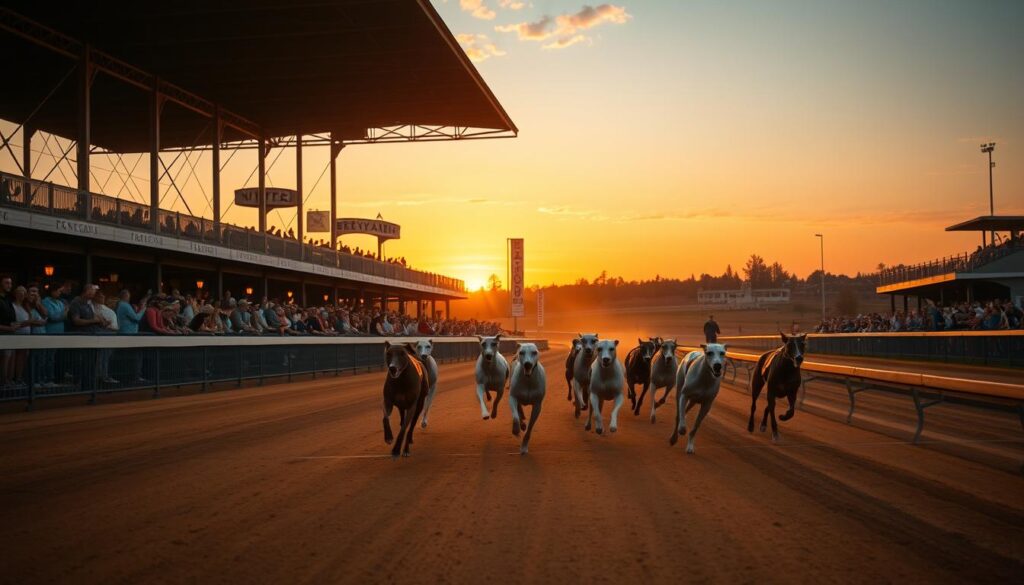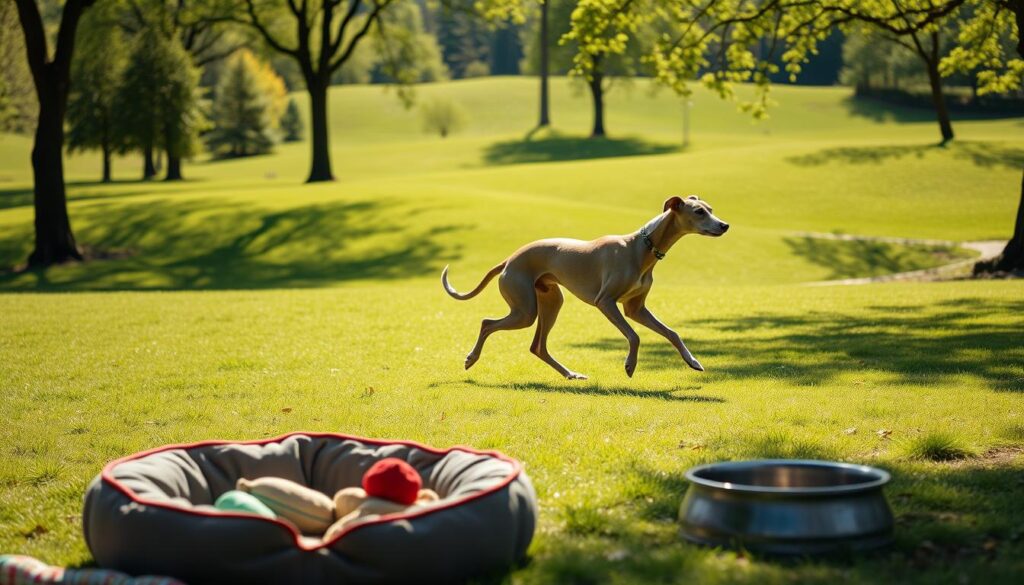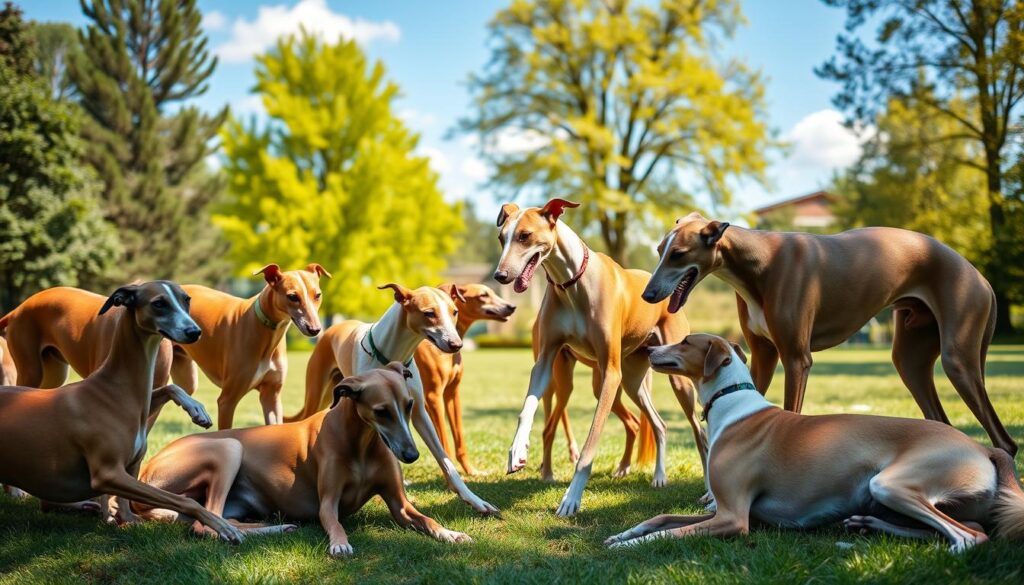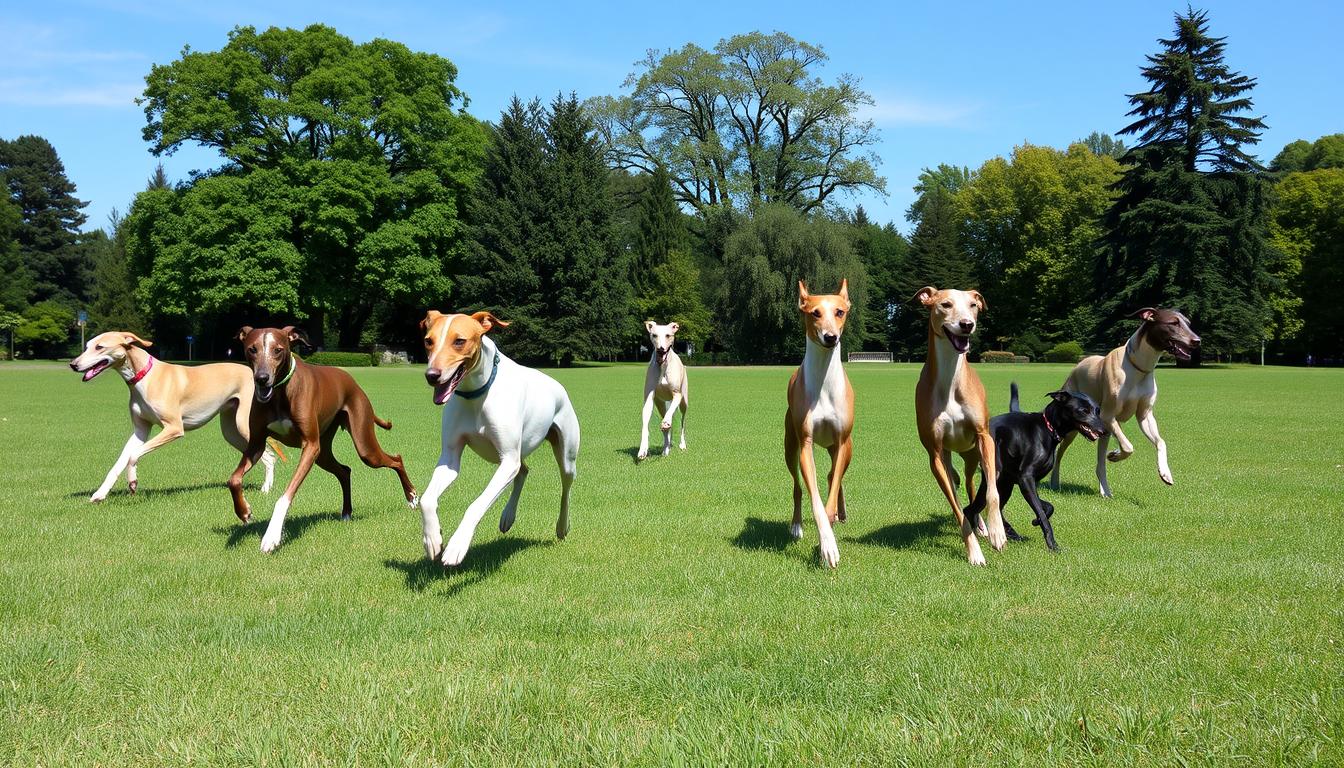Greyhounds are known for their speed, agility, and gentle nature. Knowing about Greyhound breed information is key for owners. This guide will cover their history, physical traits, diet, and training needs.
If you’re thinking of getting a Greyhound, this guide is for you. It offers insights into their behavior, care, and health. We’ll explore their exercise needs, common health issues, and training methods.
Understanding Greyhounds’ specific needs helps you care for them better. This guide will cover nutrition, exercise, training, and socialization. You’ll learn everything you need to know about Greyhounds.
Key Takeaways
- Understanding Greyhound breed information is crucial for providing proper care and attention
- Greyhounds have unique physical and behavioral characteristics that require special consideration
- A balanced diet and regular exercise are essential for maintaining a Greyhound’s physical and mental health
- Training and socialization are critical for developing good behavior and a strong bond with your pet
- Regular health check-ups and preventative care can help identify and address common health issues in Greyhounds
- With the right care and attention, Greyhounds can make loving and loyal companions
Understanding the Majestic Greyhound Breed
Greyhound breed information is key for those wanting to welcome one into their home. Their sleek coats and athletic build make them a favorite for centuries. Knowing their physical traits, breed standards, and coat colors is essential for their care.
Greyhounds have short, smooth coats in colors like brindle, fawn, and black. Their athletic build and long legs are perfect for racing. But, they also need regular exercise to stay healthy and happy. Understanding these traits helps owners give their Greyhound the best care, including a balanced diet and vet visits.
Physical Characteristics
Some key physical traits of Greyhounds include:
- Short, smooth coat that requires minimal grooming
- Athletic build with long legs and a deep chest
- Short, fine head with a black nose and rose-shaped ears
Breed Standards
Greyhound breed standards vary, but most agree they are sight hounds. They have a short, smooth coat and an athletic build. Knowing these standards helps owners appreciate their Greyhound’s unique qualities and care for them better.
Common Coat Colors and Patterns
Greyhounds have various coat colors and patterns, like solid, brindle, and fawn. Some common colors are:
- Black
- Blue
- Fawn
- Brindle
Understanding Greyhound coat colors and patterns helps owners appreciate their dog’s uniqueness. With the right care tips, anyone can enjoy a happy, healthy relationship with a Greyhound.
The Rich History of Greyhounds Through the Ages
Greyhounds have a long and fascinating history that spans thousands of years. They were highly valued for their speed and agility. The Greyhound racing history shows their development, with roots in ancient Greece and Rome.
Some key events in the Greyhound racing history include:
- The establishment of the first Greyhound racing tracks in the United Kingdom in the 18th century
- The development of the breed in the United States in the 19th century
- The rise of Greyhound racing as a popular sport in the 20th century
Today, Greyhounds are used for racing and as pets. Their gentle and affectionate nature makes them a favorite among families and individuals. The Greyhound racing history has shaped the breed into a beloved companion, known for their speed, agility, and gentle nature.
Racing Legacy: From Track to Home
Greyhound racing has a long and complex history. It has evolved over time, focusing more on the dogs’ welfare. Now, more people are adopting retired racing Greyhounds, giving them loving homes.
The sport has seen big changes, like better track designs and safety features. But, concerns about the dogs’ treatment have grown. Many now push for adopting retired Greyhounds, giving them a second chance at happiness.
The Evolution of Greyhound Racing
Greyhound racing was once a thrilling sport, drawing big crowds. But, worries about animal welfare have increased. Now, there’s a focus on helping Greyhounds transition from racing to pet life through adoption.

Transition to Pet Life
Retired Greyhounds need time to adjust to life as pets. They need training and socialization to feel at home. Organizations help match them with owners who can give them love and care.
Adopting a Greyhound is a way to help solve the controversies in modern racing. As more people learn about Greyhound history and adoption, they open their homes to these amazing dogs.
Essential Greyhound Care Guide
Keeping your Greyhound healthy and happy is key. A good life includes a balanced diet, regular exercise, and health checks. These are essential.
Here are some important Greyhound care tips:
- Feed a high-quality, nutrient-rich diet that meets your Greyhound’s nutritional needs.
- Provide regular exercise, such as daily walks and playtime, to keep your Greyhound physically and mentally stimulated.
- Regular grooming is also important, including nail trimming, ear cleaning, and brushing their coat.
By following these Greyhound care tips, you can help your pet live a long, happy, and healthy life. Always talk to a vet for advice on caring for your Greyhound.
Nutrition and Dietary Requirements
Keeping your Greyhound healthy starts with the right food. Understanding their diet is key to avoiding Greyhound health issues. They need a mix of high-quality protein, complex carbs, and healthy fats for their best health.
Feeding your Greyhound right involves several important factors. Here are the main points to consider:
Recommended Food Types
The best food for your Greyhound depends on their age, size, and how active they are. Look for a high-quality dog food that’s rich in protein and has moderate fat.
Feeding Schedule
Greyhounds can get bloat easily. So, feed them smaller meals often. Aim for two to three meals a day.
Common Dietary Concerns
Greyhounds might face food allergies, digestive problems, or obesity. Watch their food intake closely and adjust their diet if needed. By following these Greyhound care tips and staying alert to Greyhound health issues, your Greyhound can live a happy, healthy life.
Exercise and Activity Needs
Greyhounds are built for speed, but they need regular exercise to be happy and healthy. As part of Greyhound care tips, it’s key to give them a balanced routine. This should include physical activity and mental challenges.
A daily walk is a good start. You can also add playtime in a safe, fenced area.
Some great exercises for Greyhounds are:
- Short sprints
- Playtime with toys
- Leisurely walks
These activities keep your Greyhound active and mentally sharp. They also strengthen your bond with your dog.
Always put your Greyhound’s safety first when exercising. The right mix of physical and mental activities ensures a happy, healthy life. Follow the best Greyhound care tips for your pet.

Common Health Issues in Greyhounds
Many owners worry about Greyhound health issues. These dogs can face certain medical problems. Regular vet visits and a healthy lifestyle can help prevent or manage these issues. Bloat is a serious problem that can be deadly if not treated quickly.
Greyhounds may also have heart issues, osteochondritis dissecans, and eye problems like cataracts. It’s key to choose a reputable breeder who has tested the parents for these conditions. This can lower the risk of inherited diseases.
Breed-Specific Medical Concerns
Greyhounds are also at risk for specific health problems. These include Greyhound neuropathy and osteosarcoma. Regular health checks can spot these issues early, allowing for timely treatment.
Preventive Care Measures
To avoid health issues, Greyhounds need regular exercise, a balanced diet, and fresh water. Watch for signs of illness or injury, like vomiting or limping. If you see anything unusual, get vet help right away.
Regular Health Screenings
Regular health screenings are crucial for your Greyhound’s well-being. Your vet can check for heart and eye problems, among others. They can also offer advice on how to keep your dog healthy and happy.
Knowing about common health issues and how to prevent them can help your Greyhound live a long, happy life. With proper care, your Greyhound can be a loving and loyal friend.
Training Your Greyhound: Tips and Techniques
Training a Greyhound needs patience, consistency, and positive feedback. Building a strong bond with your Greyhound is key. This bond is built on trust and respect. Use reward-based training methods to encourage good behavior and avoid bad habits.
When training your Greyhound, focus on a few important areas:
- Housebreaking: Create a routine and reward your Greyhound for going outside.
- Obedience training: Teach basic commands like “sit,” “stay,” and “come” with positive reinforcement.
- Behavioral issues: Fix problems like barking or chewing by finding the cause and making a plan.
Every Greyhound is different, so tailor your training to fit their needs and personality. With time, effort, and patience, your Greyhound will become a well-behaved and loyal friend.
Living with Greyhounds: Home Adaptation
Bringing a Greyhound home means you need to think about their special needs. It’s important to make a safe space for them. This includes removing dangers, keeping toxic stuff out of reach, and blocking off risky areas.
It’s also key to introduce your Greyhound to other pets carefully. This helps avoid fights and makes the transition smoother for everyone. Adopting a Greyhound can be great, but remember to think about your current pets and make sure your home is safe for them.
Creating a Safe Environment
- Remove any hazardous materials, such as toxic substances or electrical cords
- Secure any areas that may pose a risk to your Greyhound, such as stairs or balconies
- Provide a comfortable and quiet space for your Greyhound to rest
Coexisting with Other Pets
Introducing your Greyhound to other pets should be done slowly and carefully. Start by keeping them apart and letting them get used to each other’s smells and sounds. When they seem okay, you can let them meet in the same room, but always watch them.
The Adoption Process: Finding Your Perfect Match
When you think about Greyhound adoption, finding a good Greyhound rescue organization is key. These groups help match you with a Greyhound that needs a home.
Rescue Organizations
Good Greyhound rescue organizations know a lot about the breed. They guide you through the adoption process. They have many Greyhounds, from puppies to adults, ready for homes.
Adoption Requirements
To make the transition easy, Greyhound rescue organizations have rules. These might include:
- Home visits to check your place
- Interviews to talk about your life and dog experience
- Adoption fees to help care for the Greyhound
Pre-Adoption Checklist
Before your Greyhound arrives, get your home ready. This means Greyhound-proofing your space, setting up a cozy area, and planning for exercise and training.
Greyhound Temperament and Personality Traits
Greyhounds are known for being very affectionate and gentle. They make great companions for many families. Their Greyhound temperament characteristics come from their history of speed, agility, and strong prey drive. Yet, they love to relax and enjoy comfort, earning them the nickname “40 mph couch potatoes.”
Some key aspects of a Greyhound’s personality include:
- Athleticism: Greyhounds are bred for speed and agility, making them well-suited for active families.
- Affection: Greyhounds are known for their loving and gentle nature, often forming strong bonds with their owners.
- Intelligence: Greyhounds are highly intelligent dogs that respond well to positive reinforcement training.
Understanding Greyhound temperament characteristics is key to giving them the best care. Recognizing their unique traits helps owners create a happy, healthy home for them.
Greyhounds are wonderful companions for those who love their gentle, athletic, and affectionate nature. By embracing their Greyhound temperament characteristics, owners can form a strong, lasting bond with their dog.
Socialization and Behavioral Development
Greyhounds are known for their gentle and affectionate nature. They make great pets. But, their socialization and behavior are key to their temperament. Proper socialization helps them be confident and calm in different situations.
Training Greyhounds should use positive methods, be consistent, and patient. Early training is vital. It builds a strong bond between dog and owner. As they grow, they need ongoing training and interaction to stay well-adjusted.
Early Training Period
In the early stages, Greyhounds learn basic skills like obedience and housebreaking. This time is crucial for shaping their temperament. They learn how to interact with people and other animals.

Adult Socialization Needs
Adult Greyhounds need continued socialization for their emotional and mental health. Regular exercise, play, and interaction with owners and other dogs help. A stable, loving home environment is key for their happiness and companionship.
Some important aspects of adult Greyhound socialization include:
- Regular exercise and physical activity
- Positive reinforcement training
- Social interaction with people and other animals
- Providing a stable and comfortable living environment
Why Greyhounds Make Extraordinary Companions
Adopting a Greyhound is a rewarding experience. They have a gentle, loving nature, making them great companions. With their regal stature and graceful movements, Greyhounds are surprisingly affectionate and eager to please.
Greyhounds are known for their calm, low-key temperament. They love to lounge by your side, offering a soothing presence. Their adaptability makes them perfect for various living situations, from apartments to spacious homes.
When you welcome a Greyhound into your home, you gain a loyal, devoted friend. These gentle giants form strong bonds with their families. Adopting a Greyhound enriches your life and gives a deserving pup a second chance at a loving home.
FAQ
What are the physical characteristics of Greyhounds?
Greyhounds have sleek, streamlined bodies and long legs. They have deep chests, perfect for speed and agility. They usually stand 27-30 inches tall and weigh 60-70 pounds.
What are the common coat colors and patterns for Greyhounds?
Greyhounds have many coat colors like black, white, fawn, red, blue, and brindle. They can also have patterns like particolor, flashy, and tuxedo.
What is the rich history of Greyhounds?
Greyhounds have been around for thousands of years. They were loved by ancient civilizations for their speed and hunting skills. In the 19th century, Greyhound racing made them famous.
How have Greyhounds transitioned from racing dogs to pets?
Greyhound racing has changed, and many retired dogs now live as pets. Greyhound rescue groups help them find loving homes. This gives them a peaceful life after racing.
What are the dietary requirements for Greyhounds?
Greyhounds need a diet rich in protein to keep their muscles strong. They should eat high-quality, balanced food in the right amounts. This is key for their health.
What are some common health issues that affect Greyhounds?
Greyhounds can face health problems like bloat, hypothyroidism, and dental issues. Regular vet visits and care are important. Watch for any health signs to keep your Greyhound well.
How do you train a Greyhound effectively?
Use positive training methods like clicker training with rewards. Be patient and consistent. Socialization and obedience training are crucial for a well-behaved Greyhound.
What should I consider when adopting a Greyhound?
Adopting a Greyhound means working with good rescue groups and understanding the process. Prepare your home and lifestyle for a Greyhound. They need a secure yard and time to adjust to home life.
What are the typical personality traits of Greyhounds?
Greyhounds are gentle, affectionate, and calm. They love to relax and nap but can also be playful. Give them exercise and mental stimulation.
How do I properly socialize and develop the behavior of my Greyhound?
Socialization and training are key for Greyhounds. Early exposure and training help them become confident. Keep socializing and address any behavior issues to ensure a well-adjusted Greyhound.

